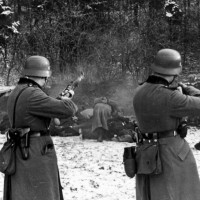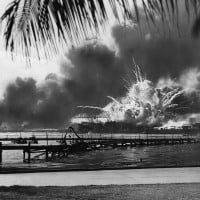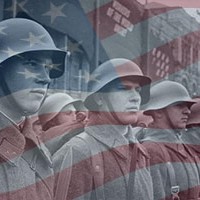Top 10 Biggest Misconceptions of World War II
Seeing as I have been diving into history and things that happened outside of the United States as of lately, (as in the past six months) I decided to put the two together, and voila, you've got this list.As we all know, World War II is arguably one of the major events that has shaped the relationship between the United States, the United Kingdom, Germany and Japan in present day. Without World War II, those four nations wouldn't be allies, or at least it would take a longer time for the four to achieve that status. But are there a few things that may have been forced into the history books to create a slightly altered narrative? Although it's not as bad as the fake news we get these days, yes, there are.

The Russians did too. The Great Purge and Holodomor were prior to WWII but it was still a country on the side of the Allies that did it.
People who study World War II as historians more than likely already knew of the inhumane and vulgar war crimes committed by Japan, including stomach-turning medical experiments, amongst other things. The thousands of American Prisoners of War were tortured and killed. But even fewer people are likely to realize that the Allied powers committed inhumane, horrendous crimes as well. Studies show that soldiers from the United States raped about 14,000 women in England, France, and Germany, and for added measure 10,000 more women in Okinawa. Not to mention that 60% of Japanese corpses in the Mariana Islands were missing their skulls, mostly because U.S. soldiers were collecting them. I could go on and on.

There are many reasons why this narrative - which you'll only hear in the United States - is not true. But let's go directly into the biggest reasoning: When World War II was over, and the Cold War had just begun, the the western world reluctant to say in the history books a history that gave the United Kingdom their due credit, or to give Russia, then neither friend nor foe, the credit. But oddly enough, the USSR is credited with defeating Nazi Germany.
The ratio of military casualties in Eastern nations as opposed to versus Western nations was an whopping nine to one, and somewhere around 80% of Germany's armed forces casualties happened in the east.
The price for the Soviet Union's casualties was quite expensive, and they lost about 10 million soldiers and maybe 13 million or so ordinary Soviet citizens. In contrast, the United States only lost 400 thousand troops.

We honor the anniversary of D-Day, in the same way we honor the anniversary of the September 11 Attacks, but were we really the leading forces? No, sadly we were not. Although operation's commander, General Dwight D. Eisenhower, was indeed an American, it was otherwise a British plan. D-Day's architect, General Frederick Morgan, air commander Chief Marshal Sir Trafford Leigh-Mallory, and the naval commander were native to the United Kingdom. Not the States. And even vehicles used on D-Day were of the mostly the United Kingdom. Britain's warships and landing craft dwarfed America's by around a little more than a four to one ratio, and British planes accounted for two-thirds of the bombers and other planes used that day . And perhaps the most baffling revelation of D-Day is that one out of three of the materials used by the American troops on D-Day came from Britain. Britain definitely carried the allied powers on D-Day, despite prior belief.

Until certain documents became declassified and available to the public eye, a couple of years ago, just about almost nobody was aware that somewhere around nine thousand Nazis and allies of Nazis escaped being held accountable for their crimes, and took asylum in South American countries such as Peru and China, after the war was concluded.
Only 6,945 Nazi war criminals actually came to attend their trials. All of them were convicted, of course. And lots of Nazis escaped did war crime charges with the help from German leaders, Argentinian leaders, and even the French leaders. And on top of that, the same Nazi scientists carried on and were key players in the space race and worked for the Soviet Union or the United States. Really, it's not that different from illegal immigrants in present day.

The reason that Nazi Germany steamrolled France in about six weeks, in early 1940 is because, France was not up to date with how they conducted warfare. France was not yet into guerrilla warfare or other technological advances, and old fashioned warfare just couldn't match the Nazis on a tactical level, and Germany's newer combat was not gonna be bested without tactics and strategy. With the more superior warfare, German units sliced through the French at amazing speed in ways that were unheard of at the time.
France doesn't really get much, if anything at all, in the history books, because they didn't put up much of a fight, and we kind of assume the French folded when Nazi Germany invaded them. France put up the best they had. But it was not enough to defeat the Nazis, hence we view the Allied powers as Great Britain, the United States, and towards the end, the Soviet Union.

We don't have the exact details, but there's enough evidence that bombing Pearl Harbor was a plan set in motion.
Tensions between the United States and the Land of the Rising Sun, Japan, had been high for more than ten years before Pearl Harbor was bombed, and the United States even established an official war plan against Japan in 1924. By the time peace treaties were being negotiated, a poll was taken in 1941, still prior to the bombing of Pearl Harbor, a vast majority in the States- elected officials and citizens alike- agreed that Japan and the United States were close to a breaking point. A whopping fifty two percent of Americans anticipated a war with Japan. Twenty seven percent didn't, and the remaining eleven percent were indecisive. It was not spontaneous. It was premeditated.

It is true that the United States hadn't declared war or deployed any troops until the bombing of Pearl Harbor, the United States was involved in the second world war prior to that fateful day. Mostly indirectly. In June, 1941, six months before Pearl Harbor, the United States passed legislation to enact the Lend-Lease program, which, when put in effect, sent the modern equivalent of $659 billion worth of weapons and supplies to France, Great Britain, and other allies fighting the war. And it was the sanctions that the United States had put on Japan that resulted in Pearl Harbor being bombed.
To suggest that the United States was isolated, minding our own business business before December 7, 1941 is a lie, although it is true that that's when we got directly involved.

A good percentage of the Americans' uniquely, and ridiculously inaccurate narrative that World War II was "the good war" was the idea that thousands of millions of young American men would give up their everyday lives to fight in World War II because they knew that it a justified decision, and the right thing to do. Lots of movies put this false narrative on World War II. Take Captain America: the First Avenger for example. Steve Rogers and his friend Bucky seemed like they wanted to fight this war, and there are other things to consider, if you look for it, I'm sure. But on the contrary, according to statistics, during World War II, two thirds of the United States forces were drafted, not enlisted, which means that only 33.3% of our forces could possibly be "excited" for this war.

It is true that beyond a shadow of a doubt that somewhere around six million Jews were killed in cold blood in concentration camps, run by the Nazis. But what they don't tell you is that only makes a little bit more than half of the casualties from World War II, and that Nazis killed much more ethnic groups than just the Jews.
The other half of the Holocaust's death toll are a collectively five million people killed in concentration camps to exterminate ordinary civilians, who were either communists, Romanians, Serbian, Polish intelligence from allied countries, homosexuals, the crippled, and much more. It's not just Jews. They killed just about everyone.

Given Joseph Stalin changed sides after Hitler invaded the Soviet Union, we often forget that Stalin was helping Hitler in his endeavor in mass genocide, and we forget about the Gulags. Basically, the Soviet equivalent to concentration camps.
Stalin's plans were not to kill an entire group of a certain religion. Stalin started the Gulags as a way to help the Russian economy, but in the end, they were turned into places to keep those Stalin wanted dead. There were less deaths in Gulags, as opposed to Nazi concentration camps, but there are no memoirs from Gulag survivors. Given Russia is still an enemy of the west, we have to wonder if the Kremlin gave us accurate numbers for deaths, or if there were any survivors, to begin with. And to top it off, the Gulags gave out food based on how much someone worked, whereas concentration camps always made sure prisoners had enough food to keep suffering. It's a disturbing discussion to have as far as which is worse, between Gulags and concentration camps.

The Germans were virtually equal to the US in nuclear development through 1944, and only as their war effort fell apart did their advancement stop. If the war had lasted 6-8 more months, Hitler would definitely have unleashed a nuke. Probably in southern Europe, but possibly in the UK.
Nuke was invented in 1945, why would nations make weapons that can wipe out the civilization, U.S. had dropped the nuke on Hiroshima and Nagasaki also 214,000 people were killed and wiped out in 1945, nations should not have nuclear weapons.

Few seem to realize that 400,000 Axis soldiers landed in the U.S. between 1942 and 1945. Thankfully for the Americans, however, those 400,000 were prisoners of war. Dozens of American prison camps across the country housed the hundreds of thousands of prisoners that the European Allies, namely the British, simply didn't have room for. And by all accounts, the conditions in these camps were pretty good. Prisoners were paid for their labor and provided with amenities like theater, games, and books it was a "golden cage," one prisoner later said.